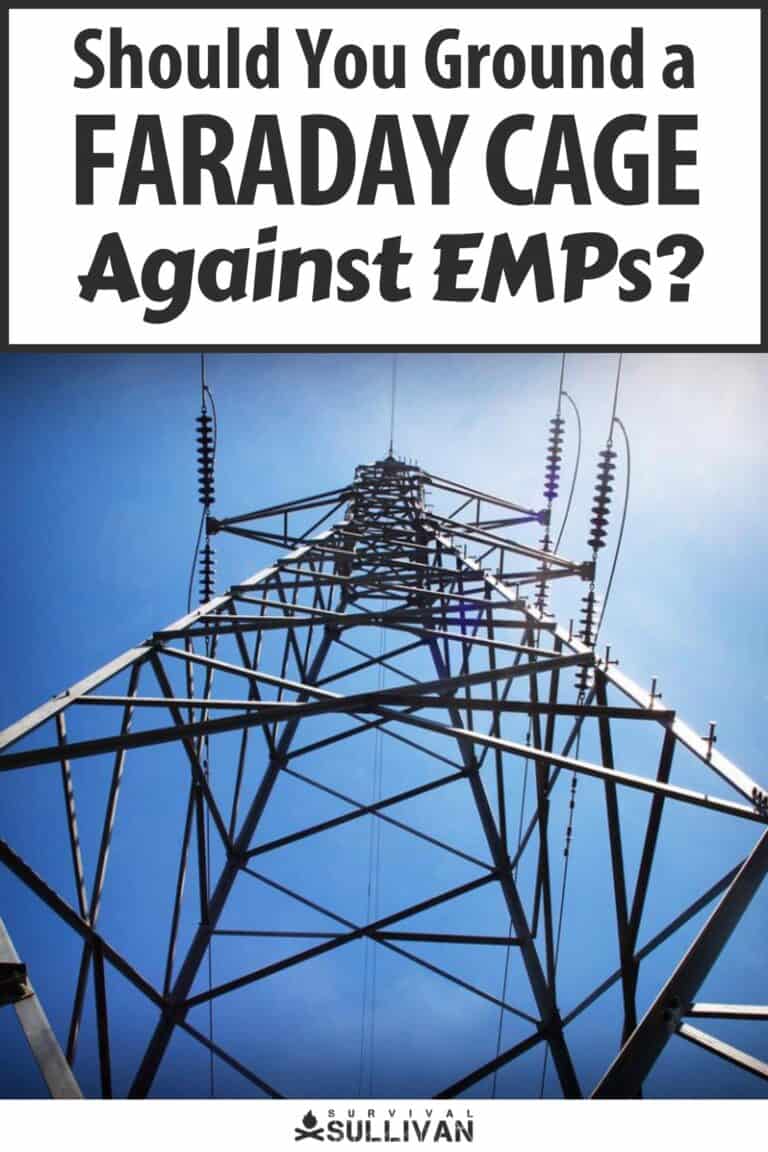An EMP, or electromagnetic pulse, is a burst of energy that can cause serious damage to electronic devices.

It can be caused by a solar flare, a nuclear explosion, or even a high-altitude detonation of a specialty EMP generating weapon.
When an EMP occurs, any unshielded devices vulnerable to it will be severely damaged or destroyed.
This is why it’s important to protect your devices from EMPs with a Faraday cage, and some recommend grounding it for even better protection.
But does that offer any real benefits? Should you ground the Faraday cage?
No, you shouldn’t ground a Faraday cage for EMP protection. The cage will do its job just fine without being grounded. Grounding does very little to protect against an EMP except in cases where the Faraday cage itself is very near the EMP source, and even then the benefit is marginal.
On the other hand, grounding might help to protect against electrostatic discharge currents, however.
Since the source of an EMP is highly likely to be very far from the Faraday cage, you won’t even be able to gain the marginal protection from the near-field if you ground it.
You can choose to ground it, but only if you want protection from strong electrical currents, like a lightning strike. In this article, we will discuss any potential benefits of grounding a Faraday cage against EMPs.

What is an EMP and What are its Effects?
To better understand how a Faraday cage helps protect our vulnerable gear from an EMP, we need to know exactly how an EMP can damage said gear.
EMP stands for electromagnetic pulse. It is a sudden burst of electromagnetic radiation that can damage electronic equipment. EMPs can be caused by natural events, such as lightning, or by man-made events, such as nuclear explosions.
The effects of an EMP depend on its intensity, but they can range from disruptive to catastrophic. For example, a strong EMP could disable all electronic devices within its range.
This would disrupt communications, disable vehicles, and cause blackouts. A catastrophic EMP could even damage or outright destroy sensitive electronics, such as computer chips, and collapse regional power infrastructure.
This will almost certainly cause widespread loss of life from second and third-order effects. Fortunately, there are ways to protect against EMPs by shielding electronic devices.
That’s where a Faraday cage comes in.

How does a Faraday Cage protect against EMPs
A Faraday cage is an enclosure made of conductive material that protects against electromagnetic fields. The most common type of Faraday cage is a metal mesh, but any conductive material will work.
Named after British scientist Michael Faraday, who invented them in 1836, the reason it’s called a “cage” is that the metal mesh or layers block electromagnetic fields from entering or exiting the enclosure.
This is useful for protecting electronic equipment inside from EMPs and other sources of electromagnetic interference.
The principles behind Faraday cages are well understood: Faraday cages are also used in laboratories to isolate sensitive equipment from outside interference and, in some cases, they’ve even been used to prevent people from using cell phones in sensitive areas.
So, if you’re looking for a reasonable way to block out EMPs from frying your needed preps, a Faraday cage might be just what you need.
Why Grounding a Faraday Cage Doesn’t do much to Improve Protection
Some people believe that grounding a Faraday cage will improve its protective properties. Unfortunately, this is not really the case, at least when it comes to the effects of an EMP.
The grounding wire provides a path for electric current to flow, but it does not do much, if anything, to reduce the overall electromagnetic field affecting the cage.
Except in an instance where the source of the EMP itself was close enough to affect the cage by its own near-field, the extra protection is so marginal it quite literally isn’t anything worth worrying about.
In fact, the electric current flowing through the grounding wire can create its own magnetic field, which could actually make matters worse.
If you’re looking to shield your electronics from electromagnetic radiation, a Faraday cage is the right choice, but don’t waste your time grounding it – it won’t do you any good.

Grounding Can Help Protect Against Electrostatic Discharge
However, there might still be some good reasons to ground your Faraday cage. While it won’t do anything to reduce the effects of an EMP, grounding can help protect against electrostatic discharge (ESD).
ESD is a sudden and intense flow of electricity between two conductors. It can damage electronic equipment, but the main difference between ESD and EMP is that ESD only affects devices that are in direct contact with the discharge.
So, if you’re worried about ESD damaging your electronics, grounding your Faraday cage could help by giving a powerful current a direct path to the ground.
Just remember that if you’re looking for protection from an EMP, you don’t need to bother with grounding your Faraday cage it’s not going to do you any good.
But if you want to protect against both EMP and a possible high-intensity electrostatic discharge, grounding is a good idea and it won’t compromise the protection of the cage.
There is Not Much Performance Difference between DIY and Commercial Faraday Cages
When it comes to the protection offered by a Faraday cage, there is not much difference between a commercial product and a DIY version, so long as it is constructed carefully with close attention paid to basic principles.
The main difference is that commercial cages are typically made with higher quality, prefabricated materials and construction techniques, which means they’re more attractive and certainly more expensive.
However, they might not be any more effective than a DIY version! If you’re looking for something to protect your electronics in an emergency situation or on a tight budget, a DIY Faraday cage can be just the ticket.
Here are some examples of common materials that can be used to make a DIY Faraday cage:
- Boxes externally lined with aluminum foil
- Metal trash cans enclosed with a metal lid
- Cans or boxes externally lined with metal screening or mesh
As long as the enclosure is made of conductive material and has no gaps or openings, it will provide adequate protection against even strong electromagnetic fields.

The post Should You Ground a Faraday Cage Against EMPs? appeared first on Survival Sullivan.
By: Tom Marlowe
Title: Should You Ground a Faraday Cage Against EMPs?
Sourced From: www.survivalsullivan.com/grounding-faraday-cage/
Published Date: Sat, 13 Aug 2022 16:00:00 +0000
-------------------------------------------------------------------------
 CampingSurvivalistHuntingFishingExploringHikingPrivacy PolicyTerms And Conditions
CampingSurvivalistHuntingFishingExploringHikingPrivacy PolicyTerms And Conditions
